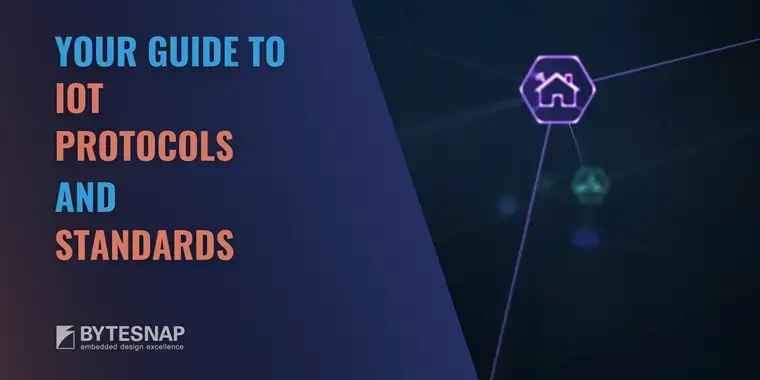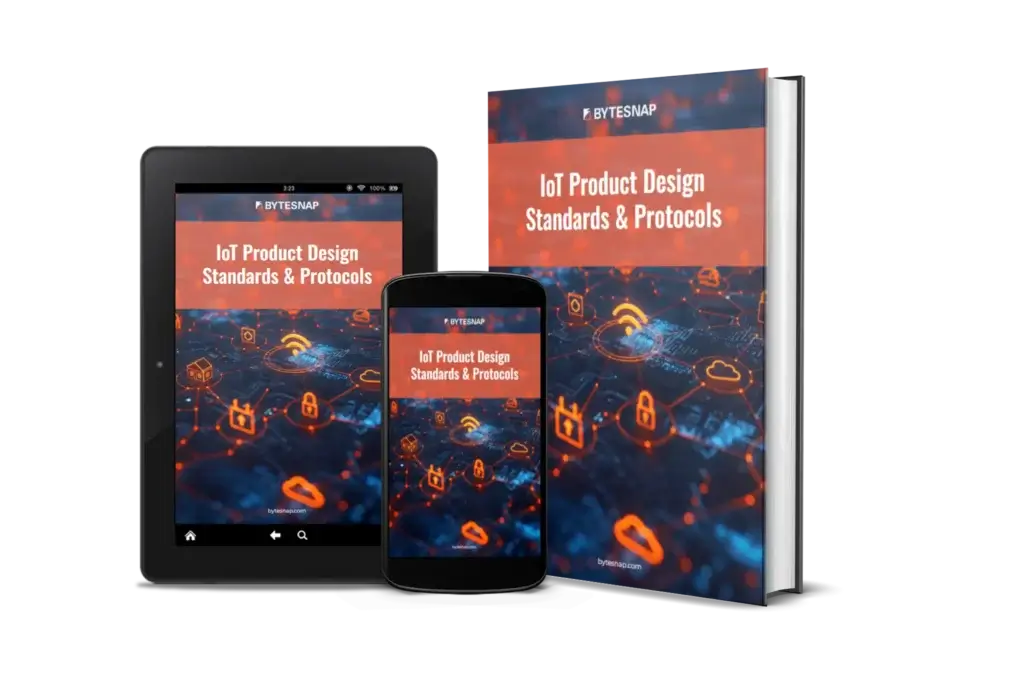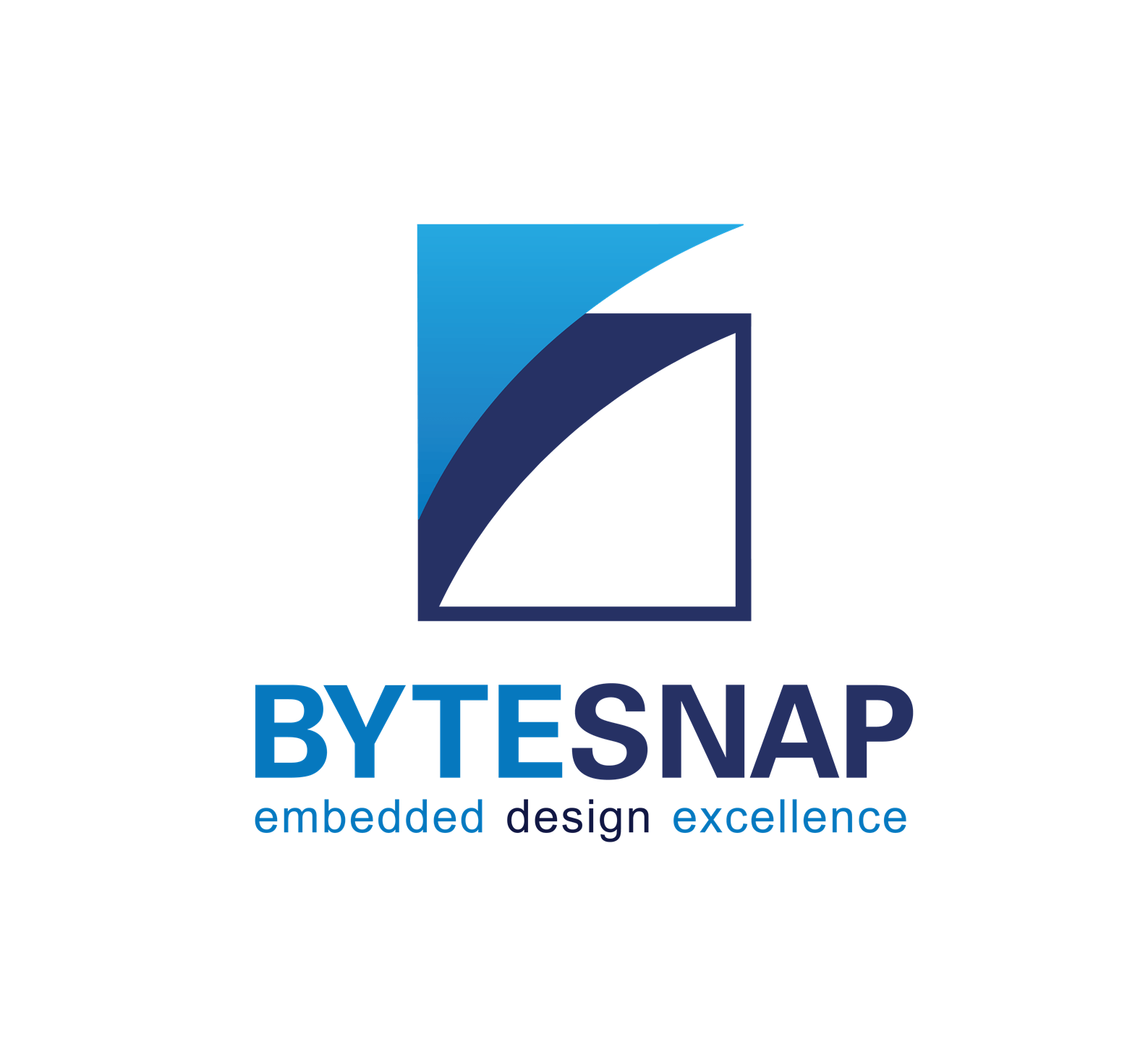Your Guide to IoT Product Design Standards and Protocols
TL;DR
- IoT product design standards and protocols are crucial for ensuring interoperability, security, and reliability in IoT devices.
- This comprehensive guide covers key IoT standards like Zigbee, Thread, and Matter, as well as essential communication protocols such as MQTT, CoAP, and HTTP.
- Learn about the importance of these standards, how to choose the right protocol for your IoT project, and get answers to common questions.
- Whether you’re an IoT product designer, business leader, or technology enthusiast, this article provides valuable insights to navigate the complex landscape of IoT standards and protocols.

The Internet of Things (IoT) is transforming our world in countless ways, from the tiniest smart dust particles to the most sophisticated smart homes and factories.
IoT continues to expand at a rapid rate; but standardising IoT devices is essential to ensuring smooth interoperability, strong security, and reliable performance.
Design standards and protocols are crucial in creating an efficient IoT ecosystem of connected devices.
Without these standards, we risk a fragmented IoT landscape where devices from different manufacturers struggle to communicate and work together effectively.
Also, inconsistencies in communication protocols and security measures can lead to potential vulnerabilities and hinder the overall performance and reliability of IoT systems.
Drawing on our work in the IoT space over the past decade or more at ByteSnap, we’ve created this comprehensive guide to give you a thorough overview of the various protocols and standards used in IoT product design.
Whether you are an IoT product designer, a business looking to integrate IoT solutions, or simply an technology enthusiast, use this handy guide as your connectivity concierge.
Table of Contents
As a highly experienced IoT product development team, at ByteSnap we’ve helped many companies define, refine, rescue, and rapidly engineer wireless device designs since 2008 and get them successfully to market.
Over the years, we’ve dealt with many IoT development queries. We’ve answered some of them in the FAQs later in this guide. For now, here are three common queries:
What's the difference between IoT Protocols, IoT Standards, IoT Frameworks and IoT Architectures?
- IoT Protocols are a set of rules and guidelines that govern the communication between IoT devices and systems.
- IoT Standards are guidelines that ensure interoperability, security, and privacy in IoT systems.
- IoT Frameworks are guidelines that define a common architecture and framework for the design, development, and operation of IoT systems.
- IoT Architectures provide a high-level view of the components and interactions of an IoT system, providing a blueprint for the design and development of IoT systems.
Why are IoT product design standards important?
Chiefly, IoT product design standards ensure interoperability between devices from different manufacturers. By adhering to a common standard, devices can communicate with each other seamlessly, reducing the need for proprietary communication protocols or gateways.
This makes it easier for consumers to set up and manage their smart home or other IoT systems, as they can choose devices from different manufacturers that work together.
IoT product design standards also help to:
- Ensure the security and privacy of data transmitted between devices. Standards such as the Matter standard include several security features such as encryption, authentication, and device identity. This helps to ensure that data transmitted between devices is secure and private, reducing the risk of data breaches and cyberattacks.
- Guarantee the reliability and scalability of IoT devices. Standards such as Zigbee or Bluetooth Mesh are designed to handle large-scale deployments of IoT devices, allowing them to communicate with each other efficiently and effectively.
- Reduce costs for electronics product designers and manufacturers. By adhering to a common standard, manufacturers can reduce the need for custom development and testing, reducing costs and time-to-market for new products.
- Drive innovation in the IoT industry. By providing a common framework for communication between devices, designers and manufacturers can focus on developing new and innovative products and services, rather than spending time developing custom communication protocols.
How do I choose the right IoT protocol for my project?
That will depend on several factors within your spec – such as the type of device, the data transfer rate, power consumption, and range requirements.
It’s best to consult with IoT product design experts, such as ByteSnap, who can help you choose the right protocol for your development.
Ultimately, IoT product design standards are crucial for electronics product designers and manufacturers as they provide them with interoperability, security, reliability, and scalability.
By adhering to these standards, manufacturers can reduce costs, improve efficiency, and deliver better products to consumers.
Let’s now go through some key IoT product design standards and protocols.
IoT Product Design Standards
IoT standards are the guidelines and specifications that ensure interoperability and compatibility between different IoT devices.
The standards define the protocols, data formats, and security requirements that IoT devices must adhere to.

IEEE 802.15.4
This defines the physical and media access control (MAC) layers for low-rate wireless personal area networks (LR-WPANs).
IEEE 802.15.4 is used as the lower layer of Zigbee, Thread, WirelessHART, and 6LoWPAN networks and is well-suited for smart homes and building automation.
Zigbee
A wireless communication standard based on IEEE 802.15.4. It is designed for low-power and low-data-rate applications and is used in smart homes, industrial automation, and healthcare.
Zigbee was the first widely adopted mesh networking system and, as such, has been perhaps the most successful IoT protocol for home automation systems after Wi-Fi.
It also predominantly, but not exclusively, runs on the 2.4GHz, worldwide licence-free band.
We have designed Zigbee products for many years at ByteSnap. In fact, we developed the world’s first Zigbee metering module, the ZMM01, back in 2013.
Zigbee was extended in 2006 with the addition of a cluster library, which allows interoperability between different vendors’ devices that adhere to it.
Zigbee was chosen, with the Smart Energy Profile, as the standard for UK smart meters that were SMETS2 compliant.
Thread
Thread has similarities with Zigbee. It too is a wireless communication standard that is based on IEEE 802.15.4 and also runs in the same frequency band.
It was released in 2015, ten years after Zigbee. Thread is designed for low-power and secure mesh networking and is used in smart homes and commercial buildings.
Thread builds up 6loWPAN to integrate IPv6 networking onto IEEE 802.15.4 which was seen as the main weakness of Zigbee as a bridge was always needed to interface Zigbee to the wider, IP-based, world (i.e., the internet!).
Thread is a newer standard and presents some advantages over Zigbee as, to a large extent, it was developed on the shoulders of Zigbee; learning from mistakes made with Zigbee and fixing the main issue – the lack of native use of IP.
However, it doesn’t define the full application layer that Zigbee does. Consequently, it doesn’t have the same inherent interoperability that Zigbee offers when products use the same clusters.
Get the Guide - with extra resources including frequency band table and IoT application decision chart

WirelessHART
WirelessHART is a wireless sensor network protocol that is commonly used in industrial applications.
It’s designed to provide reliable and secure communication between sensors and other devices in a plant or factory setting.
- Uses a mesh network topology, where each device acts as a repeater to extend the range of the network.
- Operates in the 2.4 GHz frequency band and can support up to 100 devices per network.
- Provides end-to-end encryption to secure data during transmission.
- Has low power consumption, allowing devices to operate for years on a single battery.
- Typical applications: Industrial sensors and monitoring devices, for example, temperature sensors, pressure sensors, and flow meters.
Wi-Fi
This wireless communication standard is commonly used in IoT products.
It provides high-speed data transfer and internet connectivity.
Key Features:
- Uses a point-to-point network topology, where devices connect directly to a router or access point.
- Operates in the 2.4 GHz and 5 GHz frequency bands and can support hundreds of devices per network.
- Provides high-speed data transfer, with speeds up to several gigabits per second.
- Has relatively high power consumption, which can be a challenge for battery-operated devices.
- Typical applications: Smart home devices, such as thermostats, security cameras, and lighting systems.
SmartMesh
SmartMesh is a low-power wireless sensor network protocol designed for IoT applications. It’s designed to provide reliable communication between sensors and other devices, even in challenging environments.
SmartMesh at a glance:
- Uses a mesh network topology, where each device acts as a repeater to extend the range of the network.
- Operates in the 2.4 GHz frequency band and can support up to 250 devices per network.
- Provides end-to-end encryption to ensure that data is secure during transmission.
- Low power consumption, allowing devices to operate for years on a single battery.
- Typical applications – wireless sensor networks for smart cities and infrastructure, such as parking sensors and air quality monitors.
Bluetooth Low Energy (BLE)
BLE is a wireless communication standard for low-power and short-range applications. It is used in smart homes, healthcare, and location-based services.
BLE is integrated into smartphone handsets and, therefore, has the big advantage over 802.11.4 protocols where a phone can directly interface with Bluetooth IoT devices, rather than requiring some form of bridge.
This is, however, a weakness, as the Bluetooth bands can get clogged up in densely populated environments (e.g., schools, hospitals, airports, etc.).
BLE is typically a point-to-point protocol, so the nodes have to be within range of each other to communicate rather than benefit from the hops that mesh networks provide.
However, Bluetooth 5 has added a long-range mode (lower data rate) – and later Bluetooth Mesh – to address these issues.
At the time of writing, Bluetooth Mesh has much lower adoption than Zigbee and Thread.
OneM2M
Machine-to-machine communication standard that provides a common framework for IoT devices to communicate with each other. It supports interoperability between different protocols and standards and is well-suited for large-scale IoT deployments.
ETSI EN 303 645
A standard developed by the European Telecommunications Standards Institute (ETSI) that provides guidelines for the cybersecurity of IoT devices It outlines requirements for the secure design and development of IoT devices, ensuring that they are resilient to cyberattacks.
Open Connectivity Foundation (OCF)
The Open Connectivity Foundation (OCF) is a standard that provides a common framework for IoT devices to communicate with each other. It supports interoperability between different protocols and standards and is well-suited for large-scale IoT deployments.
Matter Standard
The Matter standard, previously known as Project CHIP (Connected Home over IP), is a new open-source smart home standard developed to enable communication between different IoT devices.
Founded by the Connectivity Standards Alliance (CSA), the standard is supported by major companies such as Amazon, Apple, Google, and the Zigbee Alliance.
The Matter standard aims to provide a common language for IoT devices to communicate with each other, regardless of the manufacturer or communication protocol used.
The standard is based on IP and is designed to be secure, reliable, and scalable.
One of the key benefits of the Matter standard is interoperability. By using a common language, Matter-compatible devices can communicate with each other seamlessly, reducing the need for proprietary communication protocols or gateways.
This makes it easier for consumers to set up and manage their smart homes, as they can choose devices from different manufacturers that work together.
As Matter is adopted by more devices, it is likely to become an essential standard for the smart home industry.
The key point with Matter is that it sits on top of Thread, WiFi, or Zigbee; it doesn’t replace them.
Other IoT standards and solutions by the CSA include:
Green Power
The Green Power IoT standard is designed to provide a low-power, energy-efficient solution for IoT devices.
This standard enables IoT devices to operate using energy harvested from their surroundings, such as light, motion, or temperature changes. By using energy harvesting technology, IoT devices can operate for extended periods of time without the need for battery replacement or recharging.
Smart Energy
The Smart Energy standard provides a set of guidelines and protocols for creating energy-efficient, sustainable IoT solutions for homes and businesses.
The Smart Energy standard includes guidelines for energy management, demand response, and renewable energy integration.
Access Control
Access Control is an IoT solution that is aimed at providing secure access to IoT devices and applications.
Access Control solutions include a variety of tools and protocols for managing access to IoT devices and applications, including authentication, authorization, and identity management.
By implementing Access Control solutions, organisations can ensure that only authorised individuals or devices have access to sensitive IoT data or functionality.
JupiterMesh
JupiterMesh is a wireless mesh networking protocol that enables IoT devices to communicate with each other using a self-healing, self-organising network.
JupiterMesh is designed to be scalable and flexible, which makes it a popular choice for IoT developers and manufacturers.
Dotdot
Dotdot is another key IoT standard developed by the CSA. Dotdot is a protocol for integrating different IoT devices and applications.
The purpose of Dotdot is to allow different IoT devices to communicate with each other, regardless of their manufacturer or type. This makes it easier for developers to create interoperable IoT solutions that can work together seamlessly.
Rf4ce
Rf4ce is a wireless communication protocol for IoT devices. Rf4ce is designed to provide a reliable, efficient, and secure communication channel for IoT devices. Rf4ce is widely used in smart home applications, such as remote controls and home automation systems.
By using Rf4ce, IoT developers and manufacturers can create solutions that are easy to use and highly reliable.
IoT protocols and standards are critical to ensuring IoT devices’ interoperability, security, and reliability. Choosing the right protocol and standard for your IoT application depends on your particular requirements, such as power consumption, bandwidth, and reliability.
Note: This is an overview of some of the more popularly known IoT product design standards and protocols. There are many other IoT protocols and standards available that may be better suited to your specific use case.
International IoT Product Design Standards
There are several international standards for IoT product design developed by organisations such as the International Electrotechnical Commission (IEC) and the International Organization for Standardization (ISO).
Key international standards include:
- ISO/IEC 30141:2018 – Provides a framework for the design and development of trustworthy IoT systems, including guidelines for security, privacy, and interoperability.
- ISO/IEC 27030:2020 – Covers guidelines for the secure design and development of IoT devices, such as requirements for risk management, threat modelling, and secure coding practices.
- ISO/IEC 21823-3:2021 – Guidelines governing the testing and validation of IoT systems, including methods for evaluating the reliability and performance of IoT devices.
- ISO/IEC TR 30122:2020 – This technical report guides the use of artificial intelligence (AI) in IoT systems, covering ethical considerations, security risks, interoperability challenges, and more.
- ISO/IEC 82304-1:2019 – Provides guidelines for the safety and effectiveness of medical devices connected to IoT systems, including requirements for risk management, data privacy, and interoperability.
IoT Protocols and Cellular Technologies
IoT protocols refer to the rules and procedures that IoT devices use to communicate with each other.
Several protocols are used in IoT, including HTTP, CoAP, MQTT, DDS, and XMPP.
Each has its advantages and disadvantages and is suited for specific applications.
HTTP (Hypertext Transfer Protocol)
HTTP is a protocol used to transfer data over the internet. It is widely used in web applications and APIs and is simple and easy to use. However, it is not suitable for low-power devices as it requires a constant connection to the server.
CoAP (Constrained Application Protocol)
CoAP is a lightweight protocol designed for constrained devices with limited resources. It is well-suited for low-power devices and is used in smart homes, industrial automation, and healthcare applications.
MQTT (Message Queuing Telemetry Transport)
MQTT is a publish-subscribe messaging protocol that is widely used in IoT applications. It is efficient and reliable and supports low-bandwidth and unreliable networks.
MQTT-SN (MQTT for Sensor Networks)
A lightweight and efficient messaging protocol that is used for low-power and low-bandwidth applications. It is well-suited for applications such as smart cities and industrial automation.
DDS (Data Distribution Service)
DDS is a data-centric protocol that is used in industrial automation and military applications. It is designed to handle large amounts of data and can operate in real time.
Low Power Wide Area Network
Low Power Wide Area Network (LPWAN) protocol is used for long-range communication between IoT devices. It is well-suited for applications that require low-power consumption and long-range communication such as smart cities, agriculture, and logistics.
LoRaWAN
LoRaWAN is a proprietary protocol developed by Semtech that uses chirp spread spectrum (CSS) modulation to transmit data over long distances. It is a low-power, long-range protocol that operates in the unlicensed frequency spectrum, which means that it can be used freely without the need for a license. LoRaWAN is designed to provide secure, bidirectional communication between IoT devices and the cloud, and can support a large number of devices over a wide area.
Platform Communications Unified Architecture (OPC-UA)
OPC-UA: Open Platform Communications Unified Architecture (OPC-UA) is a machine-to-machine communication protocol that is widely used in industrial automation. It provides secure and reliable communication between different devices and systems.
Sigfox
An LPWAN protocol for low-bandwidth and low-power applications. It’s a great match for applications such as asset tracking, smart agriculture, and energy management.
Thread
A Wireless communication protocol used for low-power and secure mesh networking. It is well-suited for smart homes and commercial buildings.
Z-Wave
A Wireless communication protocol for home automation and security systems. It provides reliable communication between different devices and supports interoperability between different manufacturers.
NB-IoT: Narrowband IoT (NB-IoT)
NB-IoT: Narrowband IoT (NB-IoT) is a cellular communication protocol that is used for low-power and low-bandwidth applications. It is well-suited for applications such as smart metering, logistics tracking, and environmental monitoring.
XMPP (Extensible Messaging and Presence Protocol)
XMPP is a protocol used for instant messaging and presence information. It is well-suited for IoT applications that require real-time communication between devices.
BLE Mesh
This low-power wireless communication protocol is generally used for large-scale IoT deployments. BLE Mesh is a good fit for smart lighting, building automation and other applications requiring high scalability and reliability.
DASH7
A wireless communication protocol for low-power and long-range applications. DASH7 fits well with asset tracking, logistics, smart agriculture and similar applications.
DDS-XRCE
A data-centric communication protocol that is used in industrial automation and military applications. It is designed to handle large amounts of data and can operate in real time.
OPC-UA
Open Platform Communications Unified Architecture (OPC-UA) is a machine-to-machine communication protocol widely used in industrial automation. It provides secure and reliable communication between different devices and systems.
RPL
This routing protocol is used in IPv6 networks. It is well-suited for IoT applications needing low-power consumption and efficient communication between devices.
SICSLOWPAN
A low-power wireless communication protocol for IoT applications. It is designed to enable communication between devices over IPv6 networks with low power consumption and limited bandwidth.
TR-069
TR-069 is used for the remote management of IoT devices. This protocol enables service providers to remotely manage and troubleshoot IoT devices, reducing the need for on-site support.
The choice of IoT protocol and standard depends on the specific needs of your project. Be sure to understand the advantages and disadvantages of each protocol and standard and choose the one that best suits your requirements.
IoTProtocol | Purpose | TypicalApplications | HTTP | Protocol for transferring data over the internet | Web applications, APIs, cloud computing |
|---|---|---|
CoAP | Lightweight protocol for resource-constrained devices | Smart energy, environmental monitoring, industrial automation, healthcare |
MQTT | Efficient and reliable transfer of data between devices | Industrial automation, home automation, remote sensing, transportation, agriculture |
MQTT-SN | Protocol for MQTT communication over wireless networks | Smart homes, industrial automation, healthcare |
DDS | Protocol for real-time data distribution and communication | Aerospace, defence, healthcare, transportation |
LPWAN | Protocol for low-power, long-range communication between devices | Smart cities, asset tracking, environmental monitoring, agriculture |
OPC-UA | Platform-independent protocol for industrial communication | Manufacturing, energy, transportation |
Sigfox | Low-power network protocol for IoT devices | Smart cities, asset tracking, environmental monitoring, logistics |
Thread | Low-power mesh networking protocol for IoT devices | Home automation, building automation, industrial automation, healthcare |
Z-Wave | Low-power wireless protocol for home automation | Home automation, smart homes, security systems |
Zigbee | Cellular network protocol for IoT devices | Smart home, Industrial Control
Healthcare Systems
Smart cities |
XMPP | Protocol for real-time communication between devices | Social networking, gaming, collaboration, healthcare |
BLE Mesh | Protocol for Bluetooth communication in mesh networks | Smart homes, lighting, building automation, healthcare |
DASH7 | Low-power, long-range protocol for wireless communication | Logistics, asset tracking, environmental monitoring, smart cities |
DDS-XRCE | Protocol for DDS communication over the internet | Industrial automation, healthcare, transportation |
RPL | Protocol for routing in low-power and lossy networks | Smart grid, environmental monitoring, healthcare |
6LoWPAN | Protocol for IPv6 communication over low-power wireless networks | Smart homes, healthcare, industrial automation |
LTE-M Category M1 (Cat-M1) | Protocol for IoT devices needing low data rates, low power consumption, and extended coverage | Asset tracking, smart agriculture, M2M, smart cities |
NB-IoT | Protocol for IoT devices needing low data rates, low power consumption, and extended coverage | Smart cities, environmental monitoring, logistics, transportation |
Other IoT device design considerations
Data rate, power, and radio range are key considerations in choosing wireless IoT standards to adopt.
In addition, be sure to consider security when choosing an IoT protocol and standard. With the increasing number of IoT devices, security threats are also on the rise. Therefore, choosing a protocol and standard that provide adequate security features such as encryption, authentication, and authorisation, is essential.
The scalability of the protocol and standard should also be factored in. As your IoT project grows, the protocol and standard should be able to handle the increasing number of devices and data.
Another critical aspect – interoperability. Your IoT devices should be able to communicate with each other seamlessly, regardless of the protocol and standard used.
Top 9 Factors when Choosing Radio Systems for IoT Design
Bear in mind that the IoT industry is constantly evolving, and new protocols and standards are being developed to meet the changing needs of IoT devices.
Stay up-to-date with the latest developments in the industry and choose protocols and standards that are future-proof.
The success of your IoT project also depends on other factors, such as the hardware, software, and infrastructure used.
Therefore, it’s best to have a holistic approach when designing your IoT system and consider all aspects that contribute to its success.
Conclusion
IoT product design standards are essential for electronics product designers and manufacturers as they ensure interoperability, security, reliability, scalability, and innovation in the IoT industry. By adhering to these standards, manufacturers can reduce costs, improve efficiency, and deliver better products to consumers
In conclusion, the IoT industry is constantly evolving, and new protocols and standards are being developed to meet the changing needs of IoT devices. Stay up-to-date with the latest developments in the industry and choose protocols and standards that are well-suited for your specific use case.
By understanding the different protocols and standards available, you can make an informed decision and ensure the interoperability, security, and scalability of your IoT devices.
Looking for IoT product design support for your engineering team?
ByteSnap’s award-winning team of experienced designers and engineers has a proven track record of developing secure and reliable IoT devices that meet the needs of our clients.
Whether you’re looking to develop a new IoT product or improve an existing one, we can provide the expertise and support you need to achieve your goals.
From concept to production, we’ll work closely with you to ensure your vision is realised and your product is delivered on time and budget.
Ready to accelerate your IoT product design?

Founded in 2008, ByteSnap Design is an award-winning embedded systems design consultancy, offering a comprehensive range of services across the electronic product development lifecycle.
A highly skilled team of over 40 hardware and software engineers, our expertise spans several sectors, including IoT, automotive, industrial, medical, and consumer electronics.
The engineering consultants on the ByteSnap Editorial Team share their knowledge and practical tips to help you streamline your product development and accelerate designs to market successfully.
With their deep technical expertise and practical experience, they aim to provide valuable insights and actionable tips to guide you through the complex world of electronic product design and development, to help you bring innovative, reliable, and secure electronic products to market quickly and cost-effectively.




